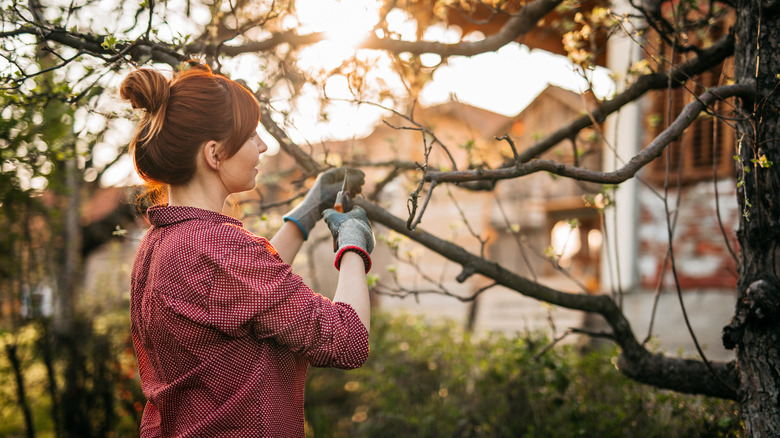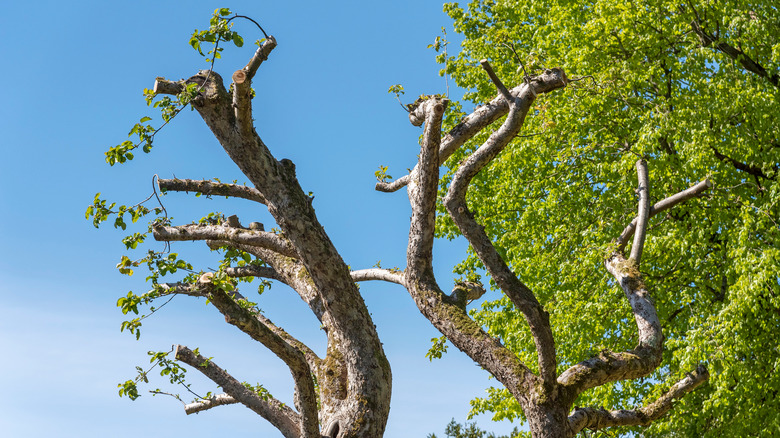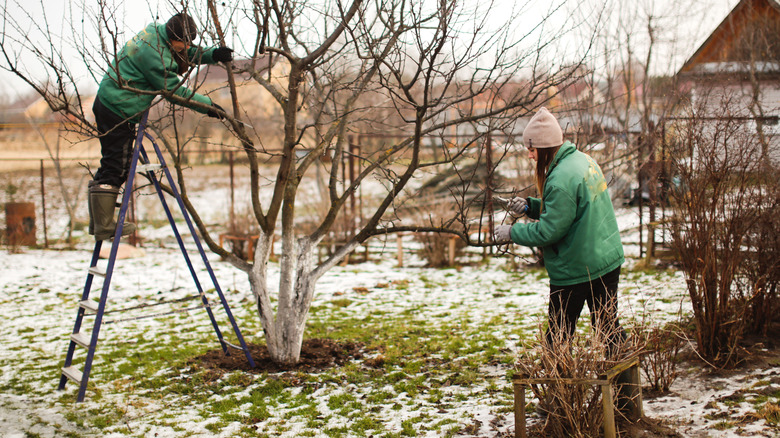Avoid This Major Mistake When Pruning The Trees In Your Yard
There are a number of reasons why you would need to prune your tree. Maybe a branch broke during a storm and needs to be trimmed back down to the base, or perhaps a branch looks infected and needs to be removed. Whatever the reason, there is one important mistake you need to avoid making, and that is over-pruning. That's because doing so can create a large amount of stress for the tree, which can put it in danger. Cutting off a branch basically makes a living wound for the plant. If you create too many, the tree becomes weakened, and it will become more susceptible to pests and diseases as it's debilitated. In most extreme cases, the tree can even die.
Not only will it be in a weakened state, but you will also be taking away one of the main ways the plant creates food and energy for itself. If you remove too many limbs at once, you're taking down a lot of leaves. Since a tree uses its leaves to create photosynthesis, which is what provides it with enough nutrients to keep growing, you can accidentally starve it. Here's how to know if you have over-pruned your tree and how to fix it.
How to know if you over-pruned and how to fix it
If you have removed more than 25% of your tree's branches, you have over-pruned. Doing this will create a large amount of trauma on the plant and severely reduce the amount of leaves left for photosynthesis. In fact, it's recommended by professionals that no more than 1/4 of the crown should be removed at any given time. If the crown requires more thinning than the recommended amount, you should craft a removal plan that spans across several years, allowing for the tree a proper amount of time to heal between bouts. If the limb removal is urgent and can't be spread across years, then it might be best to remove the entire tree. At that point, you should consult with a tree specialist or arborist.
It's very difficult to fix a tree that has been over-pruned. The best thing you can do is give it resources to heal, so make sure you provide the injured tree with plenty of water and fertilizer. Water the tree every few days, aiming to give it three buckets per week. Increase this amount if your pruning was done in the summer and there is a heat wave. As for fertilizer, make sure to test your soil with a kit to see which nutrients are in short supply or missing. This will help you choose the best fertilizer for your ailing tree. You can get it tested by sending it to your local university extension. However, outside of that, there is nothing much else you can do other than wait.
How to prune a tree safely
The best thing to do is be strategic and careful about which limbs you choose to remove. Start by only removing the most obvious offenders — aim to trim any branches that look dead, diseased, or broken. You want to be overly discerning because you can always go back in and remove more branches in the next few weeks or months. However, you can't magically make the branches you over-pruned grow back. Basically, your main goal should be to trim back as little as possible.
It also matters what time of year you perform your limb removal. Winter is one of the best times to prune trees since they're dormant, which means the procedure will create less trauma on the tree. It also means that the tree won't be able to release new growth, which is important. Pruning often makes plants release new shoots or buds, and this is one of the main reasons why you shouldn't prune during the fall. Since winter is right around the corner, you want the tree to store all of its energy to survive the rough weather ahead, rather than waste it on releasing shoots that won't be able to survive the harsh upcoming season. You also want to avoid pruning branches during the spring or summer, unless absolutely necessary. That's because you want the tree to focus all of its energy on creating flowers, fruits, or new leaves rather than healing its wounds.


